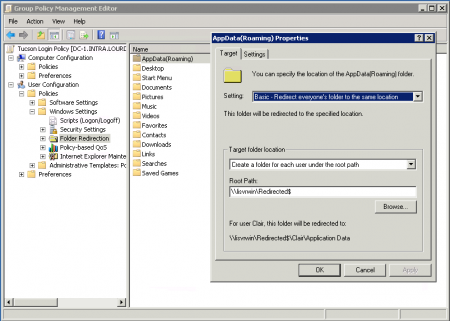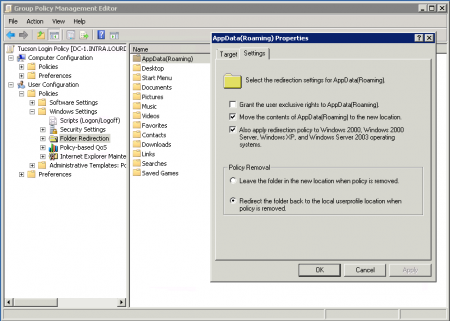User Tools
This is an old revision of the document!
Table of Contents
Folder Redirection
See also:
See also: Windows Group Policy
See also: roaming_profiles|Windows Roaming Profiles]]
See also Dealing with Low Disk Space
Detailed Terminal Server Example: http://www.virtualizationadmin.com/articles-tutorials/terminal-services/performance/configure-folder-redirection.html
http://blogs.technet.com/b/askds/archive/2008/06/30/automatic-creation-of-user-folders-for-home-roaming-profile-and-redirected-folders.aspx
http://blogs.technet.com/b/netro/archive/2010/09/01/which-minimum-share-amp-ntfs-permissions-do-you-need-for-the-use-of-offline-files-and-folder-redirection-in-windows-2008-2008-r2.aspx
http://technet.microsoft.com/en-us/library/cc766489%28WS.10%29.aspx
Folder Redirection is a newer feature of Windows that is complementary to Roaming Profiles. It can be used with or without Roaming Profiles.
Roaming Profiles can be very beneficial, but it can cause long logon/logoff cycles. Folder Redirection can help this situation by using redirection to access the bulkier parts of Windows Profiles instead of synchronizing/copying it on every logon/logoff.
Folder Redirection is:
* Complementary to Roaming Profiles
* Configured using Group Policy
* A user-based policy
* Redirection policies are usually applied to:
* Containers of user objects
* User Groups
===== Example Application =====
==== Folder Structure ====
This folder structure supports implementation of these four functions and permits the functions to be implemented separately at different times or together at once.
* Shares
* Home Directories
* Roaming Profiles
* Folder Redirection
<file>
E:\Shares
\Share1
\Share2
E:\Homes
\User1
\User2
E:\Profiles
E:\Redirected
\User1
\User2
\AppData
\Documents
</file>
<note important>Note that these settings allow for the automatic creation of per-user sub-folders of the top-level 'Redirected' folder and forbid users from accessing other users' files and folders.</note>
==== Top-Level 'Redirected' Folder Properties ====
![]() Use Advanced buttons to edit these settings as noted in the instructions below!
^User or Group ^File/Folder Permissions (Security Tab) ^Comment ^
|Administrators |Full Control |This Folder, Subfolders and Files |
|SYSTEM |Full Control |This Folder, Subfolders and Files |
|CREATOR OWNER |Full Control |Subfolders and Files Only |
|Everyone |Full Control |This Folder Only |
^User or Group ^Share Permissions (Sharing Tab) ^
|Everyone |Full Control |
<note warning>Don't use 'administrator' for testing. Use a regular user account. I don't know why, but it seems to matter.</note>
==== Configure Top-Level Folder and Sharing ====
- Create a folder “Redirected”
- Disable permissions inheritance
- Set folder permissions per the table above
- Use the Advanced option to edit permissions
- Share the folder “Redirected”
- Set the share name as “Redirected$”
- The dollar symbol hides the share
- Leave off the $ if you prefer
- Use Properties → Sharing → Advanced to create hidden shares
- Set the share permissions per the table
==== Configure Group Policy ====
See also Group Policy
^Folders You May Want to Redirect ^Comment ^
|Application Data |Can get large |
|Desktop |Can get large and nice to have accessible from another PC |
|Documents |Can get large and nice to have accessible from another PC |
|Pictures |Follows Documents |
|Music |Follows Documents |
|Videos |Follows Documents |
|Favorites |Nice to have accessible from another PC |
|Contacts |Nice to have accessible from another PC |
|Downloads |Can get large |
- Modify Group Policy
- Start → Run →
Use Advanced buttons to edit these settings as noted in the instructions below!
^User or Group ^File/Folder Permissions (Security Tab) ^Comment ^
|Administrators |Full Control |This Folder, Subfolders and Files |
|SYSTEM |Full Control |This Folder, Subfolders and Files |
|CREATOR OWNER |Full Control |Subfolders and Files Only |
|Everyone |Full Control |This Folder Only |
^User or Group ^Share Permissions (Sharing Tab) ^
|Everyone |Full Control |
<note warning>Don't use 'administrator' for testing. Use a regular user account. I don't know why, but it seems to matter.</note>
==== Configure Top-Level Folder and Sharing ====
- Create a folder “Redirected”
- Disable permissions inheritance
- Set folder permissions per the table above
- Use the Advanced option to edit permissions
- Share the folder “Redirected”
- Set the share name as “Redirected$”
- The dollar symbol hides the share
- Leave off the $ if you prefer
- Use Properties → Sharing → Advanced to create hidden shares
- Set the share permissions per the table
==== Configure Group Policy ====
See also Group Policy
^Folders You May Want to Redirect ^Comment ^
|Application Data |Can get large |
|Desktop |Can get large and nice to have accessible from another PC |
|Documents |Can get large and nice to have accessible from another PC |
|Pictures |Follows Documents |
|Music |Follows Documents |
|Videos |Follows Documents |
|Favorites |Nice to have accessible from another PC |
|Contacts |Nice to have accessible from another PC |
|Downloads |Can get large |
- Modify Group Policy
- Start → Run → gpmc.msc
- Create a new Group Policy Object (GPO) or edit an existing one
- User Configuration → Policies → Windows Settings → Folder Redirection
- Right-click each folder you want to redirect → Properties
- Target Tab
- Setting
- Basic - Redirect everyone's folder to the same location
- Target Folder Location
- Create a folder for each user under root path
- Root path: \\servername\Redirected$
- Settings Tab
- Deselect Grant user exclusive rights
* If you don't do this, administrators can't access redirected folders
- Select Also apply to Windows 2000, XP, etc.
- Select Redirect the folder back to the local userprofile location when policy is removed

 ===== Terminal Services (Remote Desktop Services) =====
http://www.virtualizationadmin.com/articles-tutorials/terminal-services/performance/configure-folder-redirection.html
===== Troubleshooting =====
* Don't use 'administrator' for testing - use a regular user account?
* Logging in through Terminal Services (as an admin) may affect folder creation?
==== Block Inheritance ====
You might try blocking Group Policy inheritance to see if upstream policies are affecting your issue.
Start → Run → gpmc.msc
Right-click the container/group → Block Inheritance
==== Delete Existing Profile and Redirected Folders ====
You might try deleting a problem user's profile and redirected folders so that they will be recreated cleanly according to your Group Policies on the next user login.
Right-click My Computer → Properties → Advanced → User Profiles**
===== Terminal Services (Remote Desktop Services) =====
http://www.virtualizationadmin.com/articles-tutorials/terminal-services/performance/configure-folder-redirection.html
===== Troubleshooting =====
* Don't use 'administrator' for testing - use a regular user account?
* Logging in through Terminal Services (as an admin) may affect folder creation?
==== Block Inheritance ====
You might try blocking Group Policy inheritance to see if upstream policies are affecting your issue.
Start → Run → gpmc.msc
Right-click the container/group → Block Inheritance
==== Delete Existing Profile and Redirected Folders ====
You might try deleting a problem user's profile and redirected folders so that they will be recreated cleanly according to your Group Policies on the next user login.
Right-click My Computer → Properties → Advanced → User Profiles**
View All Shares
View all shares including hidden shares (share name ending with $ symbol):
net share
Corrupt ntuser.dat file with Redirected Folders
- User logs in and does not get custom Desktop, Documents etc. Event log MAY show corrupt ntuser.dat file had been recovered.
- Delete the users profile from the workstation using the Advanced System Settings → Advanced Tab
- Take ownership of the users profile on the server and rename.
- Log in as user and it will recreate the users profile on the server and workstation. Custom settings, Desktop Background, Outlook configuration, Quick Launch etc. will need to be reset.

